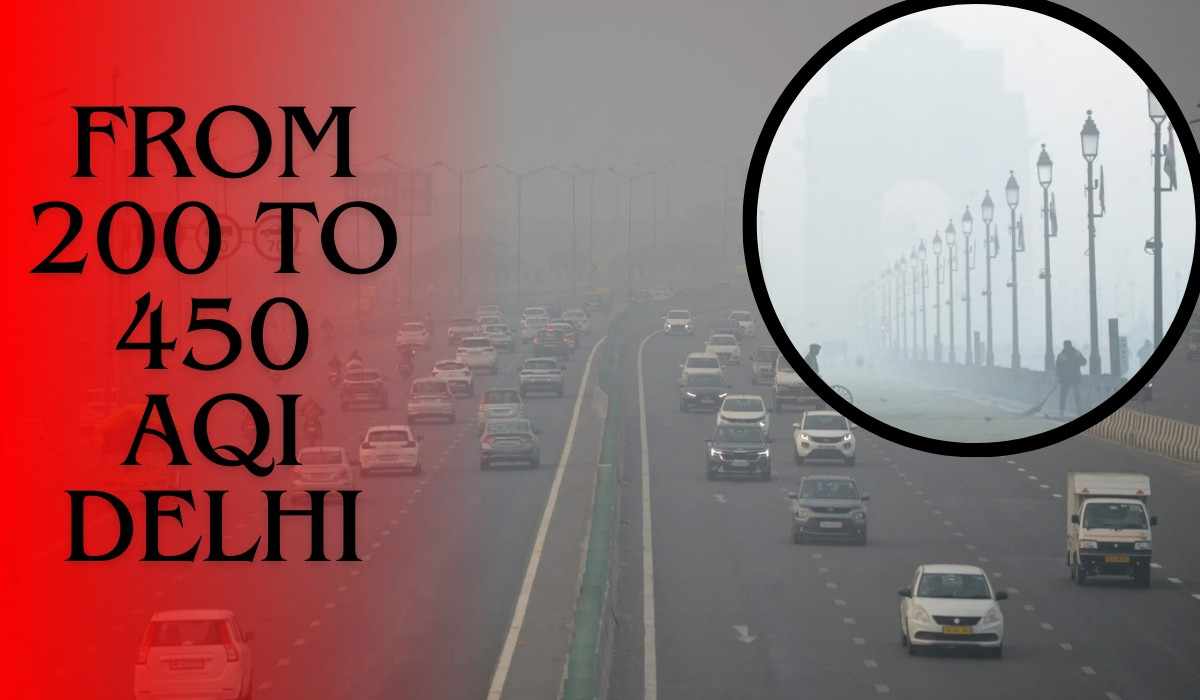Delhi’s air quality has once again plunged into the “severe” category, with the AQI delhi jumping from 200 to over 450 in just two days. According to weather experts, slow wind speed, rising humidity, and a drop in temperature have exacerbated pollution levels in the capital, leading to this sudden spike in AQI.
Sudden Spike in AQI in Delhi
On Saturday, Delhi’s AQI stood at a moderate 204, indicating an improvement. However, within just two days, it breached the severe category, reaching 450 on Monday. The combination of winter chill and rising pollution has caused a “double attack” on Delhi’s environment, impacting air quality drastically. Several areas in the city reported AQI levels above 450.
Why Did Delhi’s AQI Shoot Up to 450?
The question arises: How did the AQI in Delhi deteriorate so quickly? Environmental experts point to multiple factors:
- Slow Winds: Due to the impact of a western disturbance in northwest India, wind speed dropped significantly.
- Increased Humidity: Rising moisture levels trapped pollutants closer to the ground.
- Temperature Drop: Cold temperatures created an inversion effect, preventing pollutants from dispersing.
According to Mahesh Palawat, Vice President of Skymet Weather, these unfavorable weather conditions allowed dust particles and pollutants to accumulate, leading to a rapid rise in the AQI.
Areas with AQI Above 450
| Area | AQI |
|---|---|
| Alipur | 454 |
| Anand Vihar | 467 |
| Ashok Vihar | 459 |
| Bawana | 467 |
| Burari | 449 |
| Jahangirpuri | 468 |
| Nehru Nagar | 463 |
| Punjabi Bagh | 455 |
| Rohini | 464 |
| Vivek Vihar | 462 |
| Wazirpur | 449 |
How Pollution Escalated Over the Day
Delhi’s pollution levels rose dramatically on Monday, starting with an AQI of 351 at 9 AM. By 8 PM, the AQI climbed to 398, and within two hours, it crossed the 400 mark. Currently, Delhi’s AQI stands at over 450, firmly in the severe category. The AQI Delhi readings indicate that wind speed played a crucial role in this sharp increase.
AQI Trends in December
The first two weeks of December saw Delhi’s AQI remain between 200 and 250 due to favorable winds that helped disperse pollutants. However, with winds slowing down on Monday, smog started building up across the city. Experts suggest that without strong winds, particulate matter like PM2.5 and PM10 accumulated rapidly, pushing the AQI Delhi readings higher.
Current Situation and Outlook
According to the Delhi Air Quality Early Warning System, operated under the Ministry of Earth Sciences, air quality in the capital is expected to remain severe today (Tuesday) as well. With slow wind speed and ongoing emissions from vehicles and factories, AQI Delhi levels are unlikely to improve immediately.
GRAP-4 Restrictions Imposed
To tackle this alarming rise in pollution, the Graded Response Action Plan (GRAP) Stage-4 restrictions have been implemented in Delhi. These measures include:
- Ban on non-essential construction activities.
- Restrictions on industrial operations.
- Limits on vehicle movement in certain areas.
How the AQI in Delhi Rose: A Timeline
| Time | AQI Level |
| Monday, 9 AM | 351 |
| Monday, 8 PM | 398 |
| Monday, 10 PM | 401 |
| Tuesday | 450+ |
What to Expect Next
Mahesh Palawat of Skymet Weather predicts that wind speed is likely to pick up again by Wednesday as the impact of the western disturbance subsides. This may bring some relief to AQI Delhi levels. However, until then, residents of Delhi will have to brace for continued poor air quality.
Key Factors Affecting AQI Delhi
- Slow wind speed
- Rising humidity
- Low temperatures
- Emissions from vehicles and industries
- Dust particles trapped in the air
Final Words
The spike in AQI Delhi from 200 to 450 in just two days highlights the critical need for stricter measures to control emissions and monitor air quality. Residents are advised to stay indoors as much as possible, use air purifiers, and avoid outdoor activities until the air quality improves.
READ THIS ALSO
Delhi-NCR Faces Severe Air Quality: GRAP III Delhi NCR pollution Restrictions Enforced




